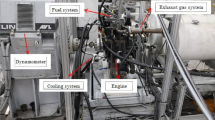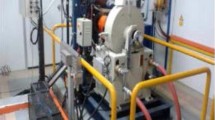Abstract
This work investigates the effects of exhaust gas recirculation (EGR) and operation parameters including engine speed, equivalence ratio, coolant-out temperature, and intake charge temperature on the basic characteristics of a single-cylinder homogeneous charge compression ignition (HCCI) engine powered with reformulated iso-octane fuels. The running range of iso-octane HCCI engine can be expanded to lower temperature and more load by adding di-tertiary butyl peroxide (DTBP) in the fuel. The combustion timing advances with the increase of DTBP concentrations, coolant temperature and equivalence ratio. The effects of EGR on the combustion and emissions are remarkable when the EGR rate is higher than 25%, and the combustion phase is sharply postponed and the UHC and CO emissions deteriorate. The intake charge temperature has a moderate effect on combustion and emissions when it is lower than 35°C; but the combustion timing advances, the combustion duration shortens, and sometimes it leads to knock combustion when the intake charge temperature increases to above 35°C.
Similar content being viewed by others
References
Kontarakis, G., Collings, N., Ma, T., 2000. Demonstration of HCCI Using a Single Cylinder Four-stroke SI Engine with Modified Valve Timing. SAE, Paper 2000-01-2870.
Lü, X.C., Chen, W., Huang, Z., 2005. A fundamental study on the control of the HCCI combustion and emissions by fuel design concept combined with controllable EGR, Part 1: The basic characteristics of HCCI combustion. Fuel, 84(9):1074–1083. [doi:10.1016/j.fuel.2004.12.014]
Noguchi, M., Tanaka, T., Takeuchi, Y., 1979. A Study Ongasoline Engine Combustion by Observation of Intermediate Reactive Products During Combustion. SAE, Paper 1979-01-0840.
Onishi, S., Jo, S.H., Shoda, K., 1979. Actived Thermo-Atmosphere Combustion (ATAC)—A New Combustion Process for Internal Combustion Engines. SAE, Paper 1979-01-0501.
Peng, Z.J., Zhao, H., Tom, M., Nicos, L., 2005. Characteristics of homogeneous charge compression ignition (HCCI) combustion and emissions of n-heptane. Combustion Science and Technology, 177(11):2113–2150. [doi:10.1080/00102200500240588]
Santoso, H., Matthews, J., Cheng, W.K., 2005. Managing SI/HCCI Dual-Mode Engine Operation. SAE, Paper 2005-01-0162.
Sjober, M., Dec, J., Cernansky, N.P., 2005. Potential of Thermal Stratification and Combustion Retard for Reducing Pressure-Rise Rates in HCCI Engines, Based on Multi-Zone Modeling and Experiments. SAE, Paper 2005-01-0113.
Yang, J.L., Todd, C., Thomas, K., 2002. Development of a Gasoline Engine System Using HCCI Technology—The Concept and the Test Results. SAE, Paper 2002-01-2832.
Yap, D., Karlovsky, J., Megaritis, A., Wyszynski, M.L., Xu, H., 2005. An investigation into propane homogeneous charge compression ignition (HCCI) engine operation with residual gas trapping. Fuel, 84(18):2372–2379. [doi:10.1016/j.fuel.2005.05.008]
Author information
Authors and Affiliations
Additional information
Project supported by the National Basic Research Program (973) of China (No. 2001CB209208), and the Basic Research Program of Shanghai (No. 05DJ14002), China
Rights and permissions
About this article
Cite this article
Qian, Zq., Lü, Xc. Characteristics of HCCI engine operation for additives, EGR, and intake charge temperature while using iso-octane as a fuel. J. Zhejiang Univ. - Sci. A 7 (Suppl 2), 252–258 (2006). https://doi.org/10.1631/jzus.2006.AS0252
Received:
Accepted:
Published:
Issue Date:
DOI: https://doi.org/10.1631/jzus.2006.AS0252
Key words
- Homogeneous charge compression ignition (HCCI)
- Iso-octane
- Additive
- Exhaust gas recirculation (EGR)
- Combustion characteristics




